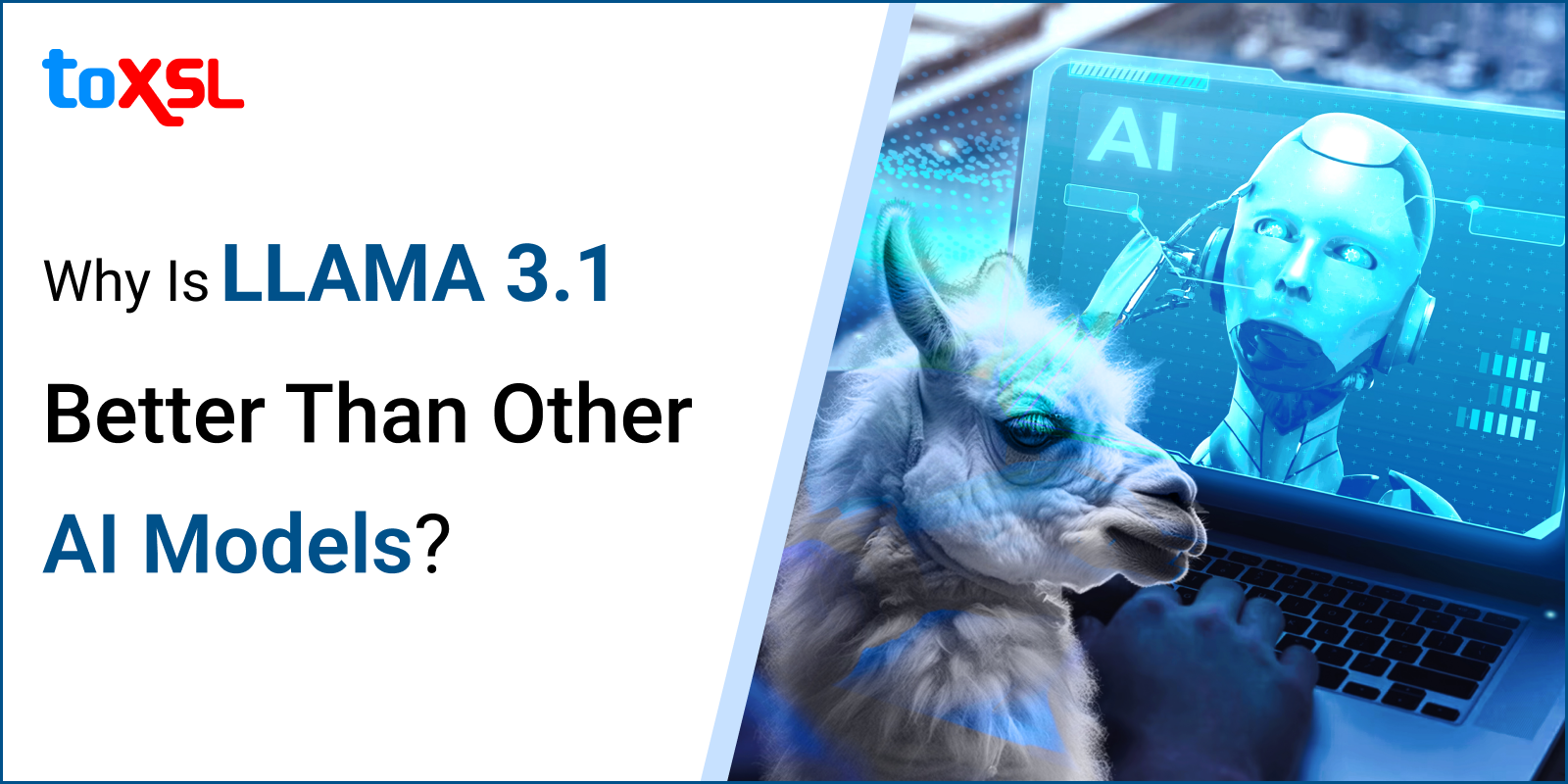- Nov 18, 2025
Share this post on:

The latest iteration of Meta's Large Language Model Meta AI (LLaMA), version 3.1, has generated significant buzz in the AI community. While comparing language models is complex and use-case-dependent, LLAMA 3.1 appears to offer some notable advantages over other prominent models. This blog delves into the reasons why LLAMA 3.1 is superior to other models, exploring its unique features, performance improvements, and the innovations that set it apart from its predecessors and competitors.
Introduction to LLAMA 3.1
LLAMA 3.1 is the latest version of the LLAMA series, a line of models developed by a leading AI research team. Building on the foundations laid by earlier iterations, LLAMA 3.1 integrates advanced technologies and methodologies to enhance its capabilities in understanding and generating human language. As AI continues to impact various industries, LLAMA 3.1 is designed to meet the increasing demands for accuracy, efficiency, and adaptability in NLP tasks.
Why Does LLAMA 3.1 Stand Out From Its Competitors?
Here are a few advantages of LLAMA 3.1 over other AI models:
1. Unmatched Accuracy and Precision
A. Refined Training Processes
One of the key advancements in LLAMA 3.1 is its refined training processes. Unlike earlier models that might use basic training datasets, LLAMA 3.1 incorporates several innovative approaches to achieve superior accuracy:
- Curated Datasets: LLAMA 3.1 is trained on an extensive and meticulously curated dataset that includes diverse linguistic sources. This comprehensive data helps the model understand various language patterns and nuances.
- Enhanced Training Algorithms: The model employs state-of-the-art algorithms that optimize learning efficiency and reduce overfitting, ensuring that the model performs well on both seen and unseen data.
B. Improved Fine-Tuning
LLAMA 3.1 utilizes advanced fine-tuning techniques to enhance its performance on specific tasks. This includes:
- Task-Specific Adaptation: The model can be fine-tuned for particular applications, making it highly effective for specialized domains such as legal, medical, or technical fields.
- Dynamic Learning Rates: By adjusting learning rates dynamically during fine-tuning, LLAMA 3.1 ensures that the model converges more effectively to optimal performance levels.
2. Superior Contextual Understanding
A. Deep Contextual Embeddings
LLAMA 3.1's ability to understand context is a major improvement over previous models. It leverages deep contextual embeddings, which allow the model to:
Capture Subtle Meanings: Deep embeddings help LLAMA 3.1 grasp the subtle nuances and meanings behind words and phrases, leading to more accurate interpretations.
Understand Long-Range Dependencies: The model can maintain contextual coherence over long passages of text, which is crucial for generating coherent and contextually appropriate responses.
B. Handling Ambiguity
Dealing with ambiguity is a challenge for many NLP models. LLAMA 3.1 addresses this by:
- Context-Aware Mechanisms: Implementing mechanisms that take into account the broader context of a conversation or text, rather than relying solely on isolated inputs.
- Adaptive Response Generation: Adjusting responses based on evolving contexts and user interactions to ensure relevance and clarity.
3. Scalability and Efficiency
A. Optimized Architecture
LLAMA 3.1 features an optimized architecture designed for efficiency and scalability. This includes:
- Streamlined Model Design: The model’s architecture is streamlined to balance computational complexity with performance, making it scalable for various applications.
- Enhanced Inference Speed: LLAMA 3.1 incorporates optimizations that improve inference speed, allowing for faster response times in real-time applications.
B. Resource Management
Efficient resource management is another strength of LLAMA 3.1. It is designed to:
- Minimize Computational Requirements: Utilize advanced techniques to reduce the computational load without sacrificing performance, making the model more accessible and cost-effective.
- Lower Latency: Ensure low latency in processing and generating responses, which is essential for interactive and real-time applications.
4. Advanced Personalization
A. Customizable Responses
LLAMA 3.1 offers advanced personalization features that enhance the user experience. These include:
- Tailored Interactions: The model can customize its responses based on user preferences, past interactions, and specific requirements, providing a more personalized experience.
- Adaptive Learning: LLAMA 3.1 learns from user interactions to improve its responses over time, making it increasingly effective in meeting individual needs.
B. Privacy and Security
In today’s data-driven world, privacy and security are paramount. LLAMA 3.1 addresses these concerns with:
- Data Anonymization: Implementing techniques to anonymize user data and protect privacy.
- User Consent Controls: Providing features that allow users to manage their data preferences and consent, ensuring compliance with privacy regulations.
5. Seamless Integration and Interoperability
A. API and Platform Compatibility
LLAMA 3.1 is designed for seamless integration with various platforms and applications. This includes:
- Flexible API: The model offers a robust API that facilitates easy integration into different systems and applications, from web services to mobile apps.
- Cross-Platform Functionality: Ensuring compatibility across various platforms, LLAMA 3.1 delivers consistent performance regardless of the environment in which it is deployed.
B. Industry-Specific Solutions
LLAMA 3.1 is versatile and can be adapted for use in multiple industries. Examples include:
- Healthcare: Assisting in medical record analysis and providing support in patient interactions.
- Finance: Enhancing customer service and automating financial report generation.
- Education: Offering personalized learning experiences and intelligent tutoring systems.
6. Cutting-Edge Innovations
A. Novel Algorithms and Models
LLAMA 3.1 incorporates several cutting-edge algorithms and techniques that set it apart from other models:
- Generative Adversarial Networks (GANs): Used to enhance text generation capabilities and ensure more realistic outputs.
- Self-Supervised Learning: Leveraging self-supervised learning to improve the model’s ability to understand and generate human-like text.
B. Continuous Improvement and Updates
The development team behind LLAMA 3.1 is committed to ongoing improvement. This includes:
- Regular Updates: Continuously updating the model based on user feedback and advancements in research to maintain its leading edge.
- Feedback Loop: Incorporating real-world feedback to refine and enhance the model’s performance and features.
7. Real-World Applications and Impact
A. Business Applications
LLAMA 3.1 has a significant impact on various business applications. Its capabilities enable:
- Enhanced Customer Support: Automating responses and providing accurate information to improve customer service.
- Content Creation: Assisting in the generation of high-quality content for marketing, communication, and other purposes.
B. Educational and Research Tools
In education and research, LLAMA 3.1 supports:
- Personalized Learning: Adapting educational materials and interactions to individual learning styles.
- Research Insights: Helping researchers analyze and generate insights from large volumes of textual data.
C. Healthcare and Beyond
LLAMA 3.1’s potential extends to healthcare and other sectors, where it can:
- Assist in Medical Research: Analyze medical literature and assist in clinical decision-making.
- Support Public Services: Enhance interactions with public services and improve accessibility.
How to Build Advanced Models with LLAMA 3.1?
Here’s how developers can build advanced models with LLAMA 3.1:
A. Setting Up the Development Environment
1. Obtain Access:
- Licensing: Ensure you have the appropriate licensing for LLAMA 3.1. This might involve obtaining an API key or downloading model weights, if available.
- Platform Compatibility: Verify that your development environment is compatible with LLAMA 3.1, including dependencies and hardware requirements.
2. Install Required Libraries:
- Frameworks: Install libraries and frameworks such as TensorFlow, PyTorch, or Hugging Face Transformers, depending on LLAMA 3.1’s implementation.
- Tools: Set up additional tools like Docker or virtual environments to manage dependencies and ensure consistent development settings.
B. Leveraging Advanced Features
1. Contextual Understanding:
- Deep Embeddings: Use LLAMA 3.1’s deep contextual embeddings to build applications that require nuanced understanding, such as chatbots or virtual assistants.
- Long-Range Dependencies: Implement solutions that benefit from the model’s ability to handle long-term dependencies, such as document summarization or multi-turn conversations.
2. Personalization:
- User Profiles: Develop features that leverage LLAMA 3.1’s personalization capabilities to tailor interactions based on user profiles, preferences, and histories.
- Adaptive Learning: Implement adaptive learning mechanisms to continuously improve model responses based on user feedback and interaction data.
C. Integration and Deployment
1. API Integration:
- RESTful API: Develop APIs to expose LLAMA 3.1’s functionality, allowing other applications to interact with the model via HTTP requests.
- GraphQL API: For more flexible queries and responses, consider using GraphQL to provide a tailored data retrieval experience.
2. Cross-Platform Deployment:
- Web Applications: Integrate LLAMA 3.1 into web applications using frameworks such as Flask, Django, or Node.js to provide advanced NLP capabilities.
- Mobile Applications: Deploy LLAMA 3.1’s functionality in mobile apps using platforms like React Native or Flutter, leveraging cloud-based services for heavy lifting.
3. Scalability and Performance:
- Load Balancing: Implement load balancing strategies to handle high volumes of requests and ensure smooth performance.
- Caching: Use caching mechanisms to reduce latency and improve response times for frequently accessed data.
D. Monitoring and Maintenance
1. Performance Monitoring:
- Metrics Tracking: Monitor key performance metrics such as accuracy, response time, and user satisfaction to evaluate model effectiveness.
- Error Handling: Implement robust error handling and logging mechanisms to identify and address issues promptly.
2. Continuous Improvement:
- Feedback Loops: Incorporate user feedback and performance data to iteratively improve the model and update it with new training data.
- Model Updates: Stay informed about updates to LLAMA 3.1 and apply improvements or bug fixes as needed.
Conclusion
LLAMA 3.1 represents a significant advancement in the fields of artificial intelligence and natural language processing. Its superior accuracy, contextual understanding, scalability, and personalization features set it apart from other models. With its cutting-edge innovations, seamless integration capabilities, and commitment to continuous improvement, LLAMA 3.1 is poised to make a lasting impact across various industries and applications.
As AI technology continues to evolve, LLAMA 3.1 stands as a testament to the progress and potential of modern models. Whether enhancing business operations, advancing educational tools, or contributing to research and healthcare, LLAMA 3.1 is well-positioned to lead the way in the future of artificial intelligence. If you are looking for the best generative AI solutions company, ToXSL Technologies is your ideal partner. We provide tailored artificial intelligence services designed to drive business growth and increase revenue. Reach out to discover how our expert team can leverage AI to elevate your business performance.
FAQs
Q1: What makes LLAMA 3.1 different from other AI models?
A: LLAMA 3.1 stands out due to its enhanced reasoning, faster processing speed, and better contextual understanding. It performs exceptionally well in both conversational ai model training services and content creation. Unlike older models, it’s more accurate, reliable, and adaptable to various applications, making it a smarter and more efficient choice for businesses and developers.
Q2: How does LLAMA 3.1 improve accuracy in AI tasks?
A: LLAMA 3.1 is trained on a larger, more diverse dataset, allowing it to deliver accurate, relevant, and human-like responses. Its advanced architecture reduces errors and improves language understanding. This results in better performance across tasks like content writing, coding, chatbots, and data analysis—making it ideal for business automation and decision-making processes.
Q3: Can LLAMA 3.1 support multiple languages and industries?
A: Yes, LLAMA 3.1 supports multiple languages and is easily customizable for different industries like healthcare, finance, education, and retail. Its adaptability makes it suitable for creating multilingual apps, chatbots, and content. Whether you're targeting local or global users, LLAMA 3.1 delivers relevant, culturally aware, and context-rich outputs for any business sector.











